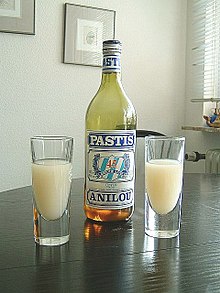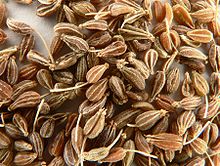anise
| anise | ||||||||||||
|---|---|---|---|---|---|---|---|---|---|---|---|---|

Anise ( Pimpinella anisum ), illustration |
||||||||||||
| Systematics | ||||||||||||
|
||||||||||||
| Scientific name | ||||||||||||
| Pimpinella anisum | ||||||||||||
| L. |
Anis ( federal German and Swiss Standard German : [ Anis ]; Austrian High German : [ aːnɪs ]; Pimpinella anisum ) is a plant species in the family of Umbelliferae (Apiaceae). Anise is used as a spice and medicinal plant and was the medicinal plant of the year in Germany in 2014 . The fruits of the plant are also called anise.
etymology
The name anis (Middle High German anīs ) goes from Latin anisum to the Greek word ānison , perhaps also ἄνηθον ( anēthon ), as possibly related to the Greek anemos , "scent", designation of Egypt (cf. Arabic anīsūn ) from the Orient Greece got the plant (anise, originally maybe also dill , that is Anethum graveolens , and other fragrant umbellifers) or their seeds.
description
Vegetative characteristics
The anise plant grows as an annual herbaceous plant and reaches heights of 10 to 60 centimeters. The tap root is thin. The upright, highly branched stem is slightly hairy. The whole plant is very aromatic.
The foliage leaves are of various shapes: the 2 to 5 centimeters long, stalked, simple basal leaves are 1 and 3 centimeters in length, heart-shaped, rounded and sawed on the edge. The stem leaves are one to two pinnate, the edges of the leaflets are serrated. The uppermost stem leaves are more and more reduced until they are only three-lobed.
Generative characteristics
The flowering period extends from June to September. The double-gold inflorescence has a diameter of 1.5 to 6 centimeters and is 7 to 15, mostly 12-rayed. The envelope (involucre) consists of one to two linear-lanceolate, 1 to 2 millimeter long bracts or is absent. The unevenly long umbel rays are 1 to 4 centimeters long. There are one to two or no linear, 2 to 3 millimeter long shells. The cones have a diameter of 5 to 10 millimeters and each contain about ten flowers. The flower stalks ("Döldchenstrahl") are initially 2 to 6 millimeters long and grow to up to 10 millimeters when the fruit is ripe.
The relatively small flowers are five-fold, hermaphroditic and radial symmetry . Sepals are absent. The five white petals have a tapped lobule at their tip. There is only one circle with five free, fertile stamens .
The fruits ( Fructus anisi ) ripen in August to September. Dry, two-part split fruits , called double achenes , are formed. The brown fruits are egg-shaped with a length of 3 to 5 millimeters and a width of 2 to 2.5 millimeters. The fruits are covered with gray hairs that distinguish them from parsley fruits . Unlike the poisonous hemlock fruits , the yellow ribs are straight.
The number of chromosomes is 2n = 18 or 20.
Occurrence and growing areas
Originally probably native to the eastern Mediterranean , such as Croatia and Albania, anise is now grown worldwide in areas with a moderate climate , especially in Central America and Central Europe, in Japan, in southern Europe and around the Mediterranean. The main cultivation area is southern Russia .
Systematics
Pimpinella anisum was first published by Carl von Linné . Synonyms for Pimpinella anisum L. are: Anisum vulgare Gaertner , Apium anisum (L.) Crantz , Carum anisum (L.) Baillon , Selinum anisum (L.) EHLKrause , Sison anisum (L.) Sprengel , Tragium anisum (L.) Link . The genus Pimpinella belongs to the subfamily Apioideae within the umbelliferae family (Apiaceae).
use
Cultivation
Anise is a light-loving plant that prefers rich soils. The soil must remain evenly moist during the growing season. During the harvest season, alternating dry and wet periods have a negative effect on the quality of the harvest. The umbels do not ripen at the same time, but one after the other, and even within an umbel the seeds ripen inconsistently. The temperature determines the duration of the growing season . Anise is harvested in August / September when the stems turn yellow. In the past, the herb was mown with a scythe and the fruit threshed.
In the Middle Ages , the plant was also grown north of the Alps , although the weather here was not reliable enough to allow the fruit to ripen every summer. Cultivation areas at this time were, for example, the area around Erfurt , Bad Langensalza , Mühlhausen and Magdeburg , where there were also aniseed oil burners that extracted the essential oil by steam distillation .
use
In western cuisine, anise is now used in bread and baked goods, mainly in spirits and liqueurs , such as sambuca , rakı , ouzo , arak , absinthe , pastis , aguardiente , chinchon and anisette ( see aniseed ). Anise is increasingly being replaced by the more productive star anise ( Illicium verum ) that comes from China . Star anise has a similar taste due to the similar composition of the essential oil , but looks different and is not closely related to real anise.
Anise also plays a role in the manufacture of confectionery . For example, in the small French village of Flavigny-sur-Ozerain ( Département Côte-d'Or ) the famous aniseed-de-Flavigny sweets are made. In southern Germany, parts of Austria, Switzerland and Hungary, one knows cookies formed with a model , which are called springerle or aniseed rolls.
The aroma is determined by anethole , which is the main component of the essential oil with 90%. Plants with a very similar aroma are fennel (which completely replaces aniseed in Asia), star anise and sweet umbel ( Myrrhis odorata ), which is seldom used these days .
Anise has long been used in both the kitchen and the fragrance industry. Excavations on Santorini have shown that anise was used in the 16th century BC. Chr. Was common, and the ancient Cretans flavored their wines alongside coriander , juniper , Dost with anise. As early as the 7th century BC Chr. Operated Athens and Corinth actively trade with scented oils, which also played a role of aniseed. Pythagoras of Samos designated around 550 BC Bread seasoned with anise as a delicious delicacy. With the Romans the anise found its way into the fine bakeries; Cakes that were served at high festivities were seasoned with aniseed fruit. This is how Virgil reports from Anise biscuits . During excavations in the Roman Coliseum , aniseed biscuits were discovered which the spectators of the gladiatorial fights had lost between the rows of seats.
Healing effect
A hot infusion ( infusion ) is due to its expectorant ( secretolytic ) and sekretomotorischen effect as a cough suppressant ( expectorant ), due to antispasmodic ( spasmolytic ) and blähungstreibender ( karminativer ) effect, also used in gastrointestinal complaints. The anise oil obtained from the fruits (Anisi fructus) by distillation is used against vermin - or incorporated into fatty oils and ointment bases, folk medicine for irritating rubs.
Anise stimulates the glands of the gastrointestinal tract . Anise tea - often mixed with fennel and caraway seeds - is used for digestive problems, flatulence, colic and cramps. For anise tea, brew 1 teaspoon of aniseed with 1 cup of boiling water and let the mixture steep for 10 minutes. Since the essential oils are partly excreted through the lungs , anise is also used in many cough teas.
Since the essential oils are stored in excretory ducts ("oil streaks"), the fruits can be pushed before use in order to accelerate the release of active ingredients. However, this will reduce the shelf life as the essential oil is volatile.
Anise in superstition and customs
The Aniskringel is a very old sacrificial dish, which in northern Germany was cooked into sweet beer - or even earlier in mead - at guild events , harvest festivals , ring riding and spring festivals . On her wedding day, too, the bride distributed these pastries to preferred guests. When she came out of church, she sat in front of "dat Hörnschapp" (corner cupboard). Every woman who gave her a present got a spoonful of sweet beer with curled curls from a pewter bowl.
Anise was considered an aphrodisiac in many rural areas . In autumn, when they returned to domestic chores after working in the fields, the women and girls prepared drinks containing anise for their husbands. On 30 November ( Andrew's Day ) it should particularly be magic powers. In Bohemia this day was called Anischtag .
According to the concise dictionary of German superstition , anise also played a role in the acclimatization of pigeons : purchased pigeons were given anise to tie them to the loft (as in Thuringia). In other areas, aniseed bread was baked on representation of the Lord and fed the pigeons with it for four weeks so that they should flourish. Elsewhere, farmers also coated their pigeon loft with anise oil to get pigeons used to the new loft.
Anise was considered a protection from bad dreams and evil eyes . In the Universal Herbal of 1820 it can be read: Anise is particularly helpful for stomach grief , to which children are particularly prone .
See also
swell
literature
- Pu Fading, Mark F. Watson: Pimpinella. In Wu Zheng-yi, Peter H. Raven, Deyuan Hong (Eds.): Flora of China . Volume 14: Apiaceae through Ericaceae . Science Press / Missouri Botanical Garden Press, Beijing / St. Louis 2005, ISBN 1-930723-41-5 , pp. 95 (English, online ).
- Avril Rodway: Herbs and Spices. The most useful plants in nature - culture and use. Tessloff, Hamburg 1980, ISBN 3-7886-9910-8 .
- Franz-Christian Czygan : Anis (Anis fructus DAB 10) - Pimpinella anisum L. Journal for Phytotherapy 13, 1992, No. 3, pp 101-106.
Individual evidence
- ↑ Der Sprachdienst , Vol. 49 (2005), p. 131.
- ^ Friedrich Kluge , Alfred Götze : Etymological dictionary of the German language . 20th edition, ed. by Walther Mitzka , De Gruyter, Berlin / New York 1967; Reprint (“21st unchanged edition”) ibid 1975, ISBN 3-11-005709-3 , p. 23.
- ^ Martin Levey : Some aspects of the nomenclature of Arabic materia medica. In: Bulletin of the History of Medicine. Volume 37, 1963, pp. 130-138, here: p. 134.
- ^ A b Pu Fading, Mark F. Watson: Pimpinella. In Wu Zheng-yi, Peter H. Raven, Deyuan Hong (Eds.): Flora of China . Volume 14: Apiaceae through Ericaceae . Science Press / Missouri Botanical Garden Press, Beijing / St. Louis 2005, ISBN 1-930723-41-5 , pp. 95 (English, online ).
- ^ Erich Oberdorfer : Plant-sociological excursion flora for Germany and neighboring areas . With the collaboration of Angelika Schwabe and Theo Müller. 8th, heavily revised and expanded edition. Eugen Ulmer, Stuttgart (Hohenheim) 2001, ISBN 3-8001-3131-5 , pp. 711 .
- ^ A b Jürgen Schultze Motel: Apiales. In: Franz Fukarek (ed.): Urania plant kingdom. Volume 3: Flowering Plants 1, Urania, Berlin 2000, ISBN 3-332-01169-3 , p. 299.
- ^ Ralf Hand, 2011: Apiaceae. Datasheet Pimpinella anisum In: Euro + Med Plantbase - the information resource for Euro-Mediterranean plant diversity. Berlin 2011.
- ↑ Heidi Driesner: [1] In: n-tv.de , February 22, 2014, accessed on March 14, 2017.
- ^ A b Max Wichtl: Tea drugs and phytopharmaceuticals: a manual for practice on a scientific basis (with the collaboration of Franz-Christian Czygan and others). 4th edition. Wissenschaftliche Verlags-Gesellschaft Stuttgart 2002, ISBN 3-8047-1854-X , p. 42.
- ↑ B. Rahfeld: Microscopic color atlas of plant drugs. Spektrum Akademischer Verlag Heidelberg 2009, ISBN 978-3-8274-1951-4 , p. 168.
Web links
- Pimpinella anisum L., anise. In: FloraWeb.de.
- Profile and distribution map for Bavaria . In: Botanical Information Hub of Bavaria .
- Thomas Meyer: Data sheet with identification key and photos at Flora-de: Flora von Deutschland (old name of the website: Flowers in Swabia ).
- Gernot Katzer spice pages on aniseed. (German and English)



